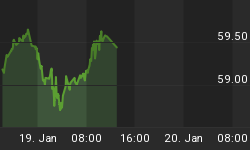Below is an extract from a commentary originally posted at www.speculative-investor.com on 8th October 2006.
December copper futures dropped to test support at 320 last week and then reversed upward (see chart below), thus prolonging the consolidation that began in May. The copper chart doesn't look particularly bullish and the next drop to 320 will probably be the one that's followed by a breakdown, but until the breakdown happens there will remain a significant chance that copper will surprise the market by breaking-out to the upside.

The reason we think an upside breakout would surprise the majority of market participants is that the opposite -- a downside breakout -- has been discounted in the share prices of copper producers. Based on current valuations it is clear to us that the stock market is expecting the copper price to drop to the low-to-mid $2 range at some point over the next several months. We've also considered a decline of this nature to be the most likely scenario, but the potential for an upside surprise needs to be taken seriously. This is especially so given that recent stock market strength suggests that we are still at least a few months away from the start of an economic downturn.
With regard to the stock market's economic message, a sizable stock market decline will not necessarily be followed by a substantial slowing of economic growth, but a substantial slowing of economic growth will invariably be preceded by a sizable stock market decline. In other words, as a leading indicator of economic recession the stock market tends to generate many false positives but no false negatives.
But, the conspiracy theorists will say, the strength in the US stock market over the past few months is largely artificial. It is, they claim, mainly the result of the US Administration's efforts to paint an unrealistically rosy picture in the lead-up to the November elections.
This conspiracy theory has many logical flaws, however, one of the most important being that the US stock market's performance over the past several months has been consistent with what's been happening in stock markets throughout the world. To be specific, global stock markets have rallied in synch from their June-July lows with each market's relative strength generally being determined by its level of commodity exposure (in general, the more commodity-oriented a stock market the worse its performance has been since the June-July lows). For example, one of the first stock markets to reach new highs for the year was the commodity-light Hong Kong market.
Another big problem with the above-mentioned conspiracy theory is that a significant driver of the GLOBAL stock market rally has been the relentless decline in the oil price, a decline that has, in turn, been driven by a rise in oil supply relative to oil consumption. That is, the decline has resulted from what's been happening with the supply of and the demand for oil in the spot market, not by what's been happening with oil-related derivatives. Furthermore, the bearish near-term supply/demand situation in the oil market has been exacerbated by the fact that there haven't been any hurricane-related supply disruptions this year. Should we therefore conclude that the US Government has figured out a way of controlling the weather?
Getting back to the base metals, the likelihood of global economic growth remaining fairly strong for another 1-2 quarters is one bullish factor. Another bullish factor is the stubbornly-low levels of metal inventories relative to daily consumption. For example and with reference to the following www.fullermoney.com chart, although the amount of copper stored in LME-approved warehouses has drifted higher over the past year the total copper inventory remains very low by historical standards (the sum total of current LME copper stockpiles is equivalent to less than three days of global consumption). And it's not like the tight supply situation is confined to copper. Lead stockpiles have shrunk to near multi-year lows over the past three months, zinc stockpiles have been trending lower in relentless fashion for almost two years, and nickel remains immersed in a high-profile supply squeeze that has not yet shown any signs of abating.

If copper is going to breakout to the downside (a daily close below 320 in the December contract would constitute such a breakout) then the coming 4-week period probably affords the best opportunity for it to do so. After that we enter the seasonally-strong period for base metals and the shares of base metal producers.
With no major growth downturn looming in the near future, with metal stockpiles low relative to demand and with 'investors' having dumped commodity stocks en masse over the past few months in anticipation of the downturn that has, to date, failed to materialise, the coming seasonally-strong period could be particularly strong.















